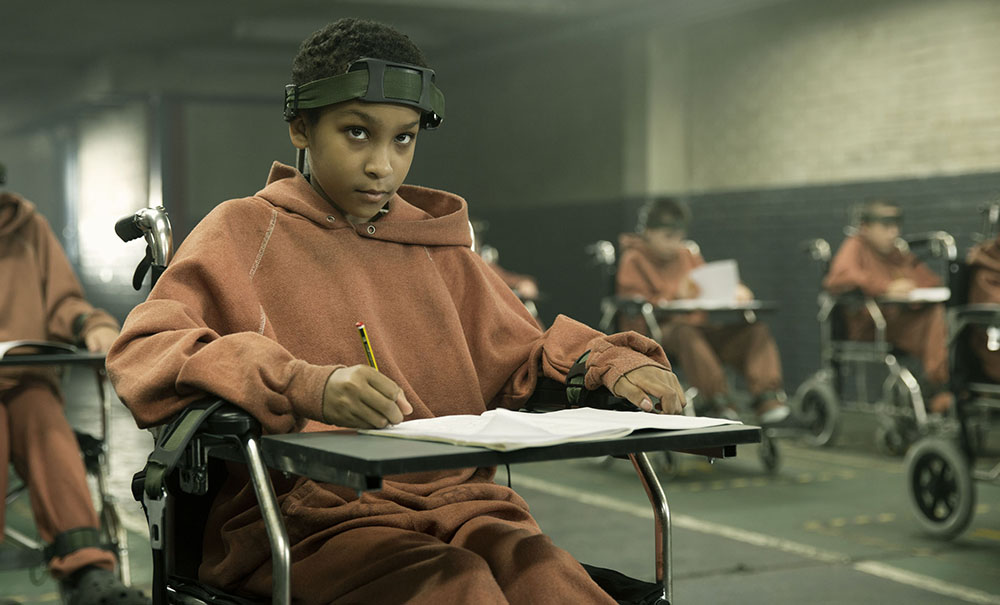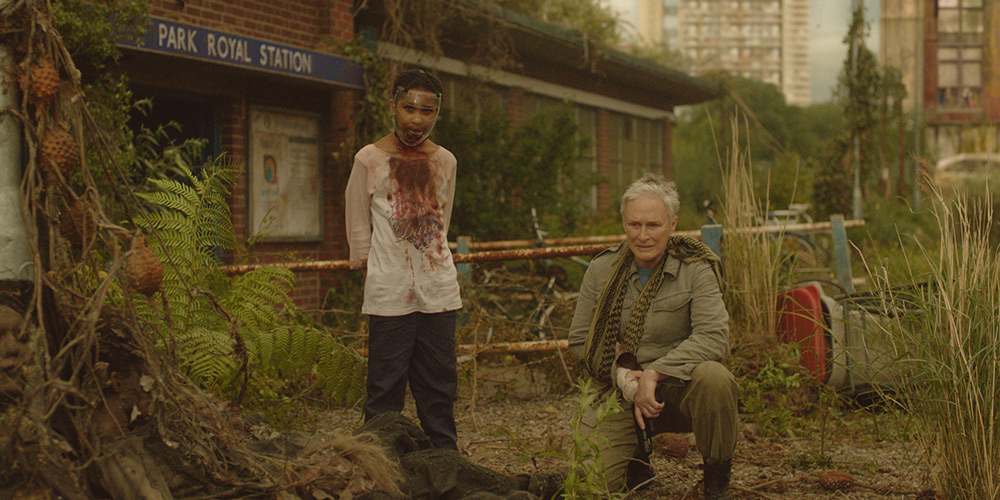 Hestia Peppe
Hestia Peppe
Night of the living symbiogenesis: director Colm McCarthy offers a new kind of zombie movie.

Still from The Girl with All the Gifts. Image courtesy Warner Bros UK.
A young black girl in a concrete cell jumps out of bed and pulls on an orange jumpsuit. She can clearly stand and walk but immediately settles herself into a wheelchair fitted with limb and head restraints. An alarm blares as she patiently waits. Soldiers come and, holding guns to her head, fasten her to the chair and take her away. The girl is called Melanie, and the camera will stay with her throughout the film, though she is not the only child locked up like this.
Off-camera, a man’s voice calls, “Come on, you friggin’ abortions.”
The Girl with All the Gifts is an independent, post-apocalyptic zombie movie. Released in the UK in September 2016, with the film now coming out in the US, it was adapted for the screen by writer Mike Carey, based on his 2014 novel of the same name. The Girl with All the Gifts may be a zombie movie, but it’s remarkably unencumbered by fidelity to the canon it cannibalizes.
Like that famous phrase of Sartre’s, “Hell is other people,” the modern figure of the zombie and its attendant apocalypse is usually conjured as a criticism of others en masse. The implication is that other people form a continuum of abject conformity that threatens to destroy the “civilized” state most optimal to the individual assigning this otherness. Here, instead, a different, liminal vision of the individual is forged in the figure of Melanie, played by twelve-year-old Sennia Nanua, in her first role in a feature-length film. Nanua’s incredibly focused and grounded performance contributes significantly to the film’s success, as does Carey’s thoughtful and compelling script.
Like her fellow inmates, Melanie is a medical and psychological test subject: presumed infectious and dangerous. The testing’s rationale is initially unclear as much, it seems, to Melanie as to the viewer, and the script withholds exposition elegantly, allowing space to consider at some length the hows and whys of these children’s incarceration. Those who have read it will not forget Ursula Le Guin’s “The Ones Who Walk Away from Omelas,” a story that tells of a utopian society founded on the misery of one imprisoned child. The claustrophobic opening sequence of The Girl with All the Gifts suggests a strong kinship between this tale and that one.
Melanie speaks in the polite, correct grammar of both Dr. Caldwell (played by Glenn Close), who leads the research project of which the children are the subjects, and the sympathetic teacher Miss Justineau (Gemma Arterton), with whom they have daily lessons. The brutish Sergeant Eddie Parks (Paddy Considine) completes the trio of authority figures from whom Melanie receives sustenance—in the form of bowls of live bugs—shelter, and language. Her strange diet notwithstanding, Melanie radiates a glad, springy agency. She knows all the answers in class, and seems to enjoy thinking and making observations about the world around her, even though strapped in a wheelchair. All of Melanie’s interactions with adults reveal the tension of their power relation, and yet what is most disturbing and affecting is that she does not resist her captors or show any kind of anger. This absence speaks more eloquently than anything explicit could. Melanie has never known life outside this routine. It’s Cristobal Tapia de Veer’s menacing soundtrack and the depression evident in the adult characters that, with minimal fuss, communicate a sense of desperation to the viewer.

Still from The Girl with All the Gifts. Image courtesy Warner Bros UK.
Miss Justineau reads the children the story of Pandora, “she who brings the gifts” in Greek—a proto-Eve invented to punish mankind and whose curiosity, in calling her to open the box, unleashed tribulation on the world, and then, finally—hope. The viewer is clearly intended to recognize Melanie as Pandora, for whom the film is named. However, when asked by Miss Justineau to tell a story of her own invention, Melanie compares her protagonist—a “special girl,” whose vulnerability is a secret—to the warrior hero Achilles. Foreshadowing the events of the film, Melanie’s girl-warrior saves “the most beautiful woman in the world” from a monster, “a frigging abortion.” Eddie Parks’s cruel words, when repeated by a twelve-year-old girl, hang in the air.
Dr. Caldwell, a pragmatist, likens Melanie to Schrödinger’s cat. Caldwell’s cruelty, like Parks’s, is predicated on her refusal to see Melanie and the other prisoners as children, or indeed people in any sense. To Caldwell, Melanie is the possibility of a cat in the box, a cat both alive and dead because it is both contained and unknowable: the possibility of a cure. Caldwell is searching for a vaccine against the parasitic fungal plague raging in the outside world. It causes the infected to feed on other humans; those who are bitten are transformed into “Hungries,” the film’s chosen epithet for its undead hordes.
It is Dr. Caldwell to whom Melanie directs her most important question—“What am I?”—and it is Caldwell, who she knows intends to kill her, who tells her the truth about her origins. Melanie and the other children are all Hungries. But, as Caldwell reveals, unlike the others they were not bitten but born “hungry” and feed on both human and zombie flesh. These children were infected as fetuses in their undead mothers’ wombs—causing them to devour the bodies of those mothers from the inside and giving Parks’s “frigging abortions” remark a truly grim new significance. As Melanie herself comes to understand, this second generation are symbionts, new organisms in which what was once human coexists with the parasitic fungus—organisms that retain, at least in Melanie’s case, consciousness, cognition, and free will.
Melanie is released from bondage when the bunker housing the research project is breached by the inevitable invasion of the undead. She saves Miss Justineau from two of them, tearing their necks out with her teeth. As the story she wrote comes true, she is forced to confront her inhumanity and that of the Hungries, and to recognize her relation to them.

Still from The Girl with All the Gifts. Image courtesy Warner Bros UK.
A monstrous, and yet still fertile subjectivity is at work in Melanie. A perhaps mycelial connection to the fungus is suggested in the preternatural way her intelligence seems to foresee events of which she cannot know; it hints toward something more expansive and connected. Intelligent, playful, even capable of love, she is not exclusively, if at all, human. The Girl with All the Gifts thrillingly invokes symbiogenesis—the cooperation between species of which Donna Haraway and Lynn Margulis have written. Neither goddess, nor cyborg, this fungal girl who brings the gifts is a singular figure, and she seems to herald a crucially different iteration of the post-apocalypse scenario. It is one that radical feminist Shulamith Firestone might have imagined: the sanctities of human reproduction and childhood are destroyed in order for the future to come to be.
Hestia Peppe is an artist, writer, and private tutor. She lives and works in London.